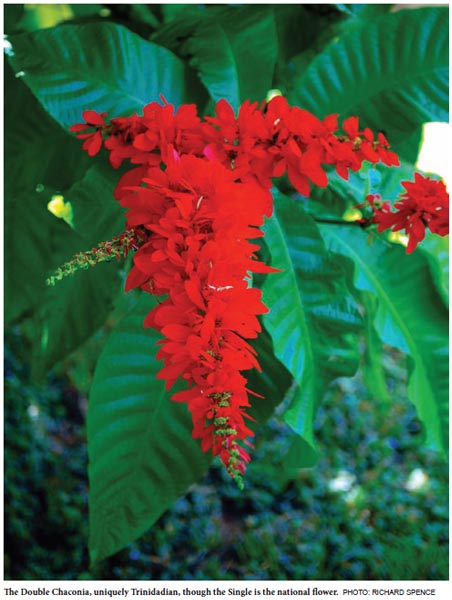 |
 |
 |
|
August 2012
|
Warszewiczia coccinea (Vahl.) Kl., exists in two forms: the wild type, known as the Single Chaconia and the cultivar—a mutant of the former, known as the Double Chaconia, both of which flower throughout the year, particularly during the rainy season. The Single Chaconia, shared with us by other countries, is the national flower, but the Double is uniquely Trinidadian and justifiably has a superior claim to hold this position. In 1957, Mrs Grace Mulloon, accompanied by two friends, one of whom was Mr David Auyong, spotted a spectacular flowering plant at the top of a group of Chaconias in the Blanchisseuse Valley. Realising the importance of their find, the group made attempts to propagate it and sought the assistance of Mr. Roy Nichols, then a plant physiologist at the Imperial College of Tropical Agriculture, St. Augustine (ICTA). By February 1958, three plants were established from rooted cuttings, one of which was sent in 1961 to Kew Gardens in the United Kingdom, where Mr J. Simmonds established four others by 1962. The plant, believed to be a mutant of Warszewicaia coccinea was given the cultivar name ‘David Auyong.’ It is of interest to note the dates involved. The bloom of the Single is a panicle (a compound inflorescence) consisting of a main axis 30-50 cm long, along which paired, stalked groups of flowers (cymes) are borne. Both the wild type and the cultivar have the same number of chromosomes. The principal differences between the two lie in the fact that whereas in the former only one of the five calyx lobes of one flower of the 20 or more that may exist in the cyme, is transformed, in the latter at least one lobe, sometimes more, of every flower in a cyme is transformed, making the inflorescence spectacularly showy. Additionally, the transformed sepals in the cultivar are not long-stalked and the corolla is not as large as that in the single: this leads to the fact the petals cannot be as easily seen as they are in the wild type. It is often mistakenly thought that the Double is the national flower. If one examines T&T’s 25 cent coin, or the Chaconia Medal, one notices the inflorescence of the Single is depicted thereon. It must be remembered that the Committee responsible for recommending various emblems would have met before the celebration of Independence on August 31, 1962. At the time of their meetings, little if anything, would have been known about the mutant (the double) other than by some members of the scientific fraternity. There is good argument for the Double to be named the national flower. A wide belt of the New World tropics, from Costa Rica to Equatorial Peru and Brazil, which belt includes Trinidad and Tobago, is home to the wild type. The mutant, however, is uniquely Trinidadian. We owe a great debt to Mr. Auyong, who at great peril to his life, procured the material from which the plant was eventually propagated. On subsequent visits by Mr. Auyong and Mr. Nichols to the site at which the plant was found, to obtain additional material for propagation, they discovered that the parent plant had been chopped down in a road-widening exercise. A point that is the subject of much discussion is the correct spelling of the common name of the species. The issue of the Flora of Trinidad and Tobago, that records the family Rubiaceae to which Warszewiczia coccinea belongs, published in 1928, by Williams and Cheesman, lists the common names as: Pride of Trinidad, Wild Poinsettia and Chaconier. No mention is made of Chaconia. The late Dr. Dennis Adams, as recorded by Quesnel and Farrell, posits that Chaconier is the correct spelling since it comes from the French word chaconne, the dance for which the dancers decorated themselves with little flags, just as the tree seems to be decorated with little flags. He draws attention to the fact that the ending ‘ier’ survives in many of the common names of French origin for our plants, such as bananier, figuier, cocoier (now often spelt cocoyea) and balisier. |


 At the time of Independence, when symbols associated with nationalism festoon public spaces, the role of the Chaconia as the national flower often comes up for scrutiny.
At the time of Independence, when symbols associated with nationalism festoon public spaces, the role of the Chaconia as the national flower often comes up for scrutiny.